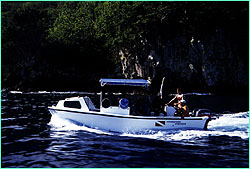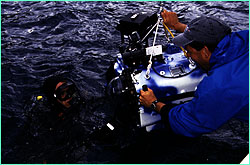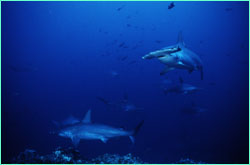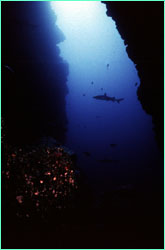 |
 |
 |
by Howard Hall October 5, 1998 I almost didn't go to the Alcyone Seamount this morning. Alcyone is on the southeast side of Cocos, and the wind has been blowing 20 knots on that side of the island for several days, producing very rough seas. And it was raining. Alcyone has been rough during this entire expedition. I feel sorry for my crew when we go to there. Half of them get seasick when we work the seamount. Our dive there yesterday wasn't much encouragement. Visibility was so poor that I aborted the dive after 15 minutes, without shooting any film. So I had lots of good excuses for not going to Alcyone this morning. But Alcyone is the only dive site at Cocos where we have consistently sighted large schools of hammerhead sharks. And a good sequence on hammerhead sharks is the last item that still needs significant work on the Island of the Sharks script. As soon as our two dive skiffs rounded Lobster Rock heading for Alcyone, I knew I had made the right decision. Although it was still rough and still raining, it wasn't as bad as I had suspected. More importantly, I could tell that the water rushing past our skiff was blue and not green, as it had been the day before. Visibility was going to be better.
Lance Milbrand descended with the camera and was met by Thurlow, who had brought down our powerful movie lights. With Cranston's help, they mounted the lights on the camera and began swimming the system in my direction. With Klapfer's help, I had selected a site on the seamount's highest peak and anxiously waited for them. A school of 200 hammerheads were passing directly over my head, and I couldn't do a darn thing without the camera. But I knew they would be back. Milbrand passed me the camera, and I waved him away. He was wearing open-circuit scuba and, ironically, the bubbles might frighten the sharks away. Milbrand took a quick look at the school of sharks and turned toward the anchorline. I settled down beside a large rock and waited for the school to return. It didn't take long. Soon I could see a massive school of hammerheads approaching from the south. I raised the camera and pressed the run switch. As a school of 100 sharks passed overhead, another school approached from the east and converged to create a school of 200 or 300. But just as the nearest shark came within 10 feet of the camera, it bolted away, causing the rest of the school to bolt as well. This is a consistent pattern when I try to film hammerheads with our IMAX camera. The machine makes so much noise that the sharks freak out just as they come close enough for a really great shot. We've made dozens of dives and spent more than 100 hours underwater trying to complete our hammerhead sequence. It's been slow going. We had been down just over one hour when I finally ran out of film. Oddly enough, the camera holds only three minutes worth of film. But at $1,000 per minute (the cost to purchase, process, and print the film), I tend to be pretty careful about when I press the run switch. In fact, we average one-and-a-half hours underwater to shoot each three-minute load.
"Surface copies, go ahead," Mark Conlin said from the camera boat. "Recover the camera," I said. "Give me a fast film change. We'll wait on the anchorline." "Surface copies." Conlin broadcast from above. "Lance is on his way. We'll give you a film change. You'll be waiting on the anchorline." Cranston, Thurlow, Klapfer, and I swam to the anchorline and began ascending. We were soon met by Milbrand hurrying our way. My decompression computer registered 15 minutes of decompression time, meaning we would have to stay at 15 feet below the surface for that long before surfacing. But we didn't plan on going up yet. Instead, we would decompress and wait for the camera. When it was reloaded, we would go right back down. At the end of the second dive I knew we would be looking at some really serious decompression time, but when conditions are good, you've got to shoot. Tomorrow the water might be murky again. It took 20 minutes to reload the camera and get Milbrand back in the water. Normally, Billy Holdson and Conlin would turn the camera around faster. But it was so rough on the surface that they had trouble holding the camera still while Holdson threaded the film. Milbrand threw up twice. Hanging on the anchorline was much nicer. I felt sorry for them up above. I did some time on the camera support boat last trip when I had to stay out of the water due to an ear infection. I can tell you that trying to load that camera on a rough day at Alcyone is a foolproof foundation of a successful weight-loss program. I also felt sorry for my wife Michele and Peter Kragh on the dive skiff (the second of the two boats we had anchored at Alcyone). They waited for us to finish with the IMAX camera so that Michele could come down to shoot production stills. I'm sure she wasn't having a very nice day either. Although only 97 pounds, I am constantly amazed at how tough Michele is.
As the four of us in rebreathers dangled from the anchorline beginning our 30 minutes of decompression time, I thought about the last few shots I'd taken. I was in such a hurry that I think I may have underexposed the first few shots and possibly set the focus wrong on the last one. I won't know for sure until I'm back in California three weeks from now, when I can view the footage on the big screen. But to be conservative, I plan to shoot the same scenes tomorrow if I get a chance. Michele and Kragh passed us on their way to the bottom to shoot some still photos. A few minutes later, Milbrand and Conlin followed. When we four rebreather divers left the water, we had been down just over two hours. On the way back to the Undersea Hunter, I could hear the guys on the camera boat singing the theme to Gilligan's Island at the top of their lungs as waves broke over the bow of their skiff and drenched them in salt water. Soon my comrades of the dive skiff joined in the chorus. I realized once again that if Island of the Sharks turns out to be a great film, it will largely be because I have such a great crew. Howard Hall is the director and cinematographer of Island of the Sharks. Photos: (1,2) Peter Tyson; (3) ©Howard Hall/Howard Hall Productions; (4) ©Michele Hall. Hammerheads or Bust (Sept. 23) Get Used To It (Sept. 25) Nature Reigns at Cocos (Sept. 27) The PIG and the Process (Sept. 29) Hammerheads Sighted (Oct. 1) Assault on Cocos (Oct. 3) The Director's Cut (Oct. 5) Swimming with Whitetip Reef Sharks (Oct. 7) The Magnificent Seven (Oct. 9) The Search for Lake Cocos (Oct. 11) Courtship of the Marbled Rays (Oct. 13) Of Booby and Beebe (Oct. 15) Taken by Surprise (Oct. 17) "This is Cocos, This is Cool" (Oct. 19) Cocos Island | Sharkmasters | World of Sharks | Dispatches E-mail | Resources | Site Map | Sharks Home Editor's Picks | Previous Sites | Join Us/E-mail | TV/Web Schedule | About NOVA Watch NOVAs online | Teachers | Site Map | Shop | Search | To Print PBS Online | NOVA Online | WGBH © | Updated June 2002 |
 Heading to Alcyone.
Heading to Alcyone.
 Lance Milbrand (in water) takes the IMAX camera from Billy Holdson.
Lance Milbrand (in water) takes the IMAX camera from Billy Holdson.
 Scalloped hammerheads swinging past Alcyone.
Scalloped hammerheads swinging past Alcyone.
 Towards the surface
Towards the surface